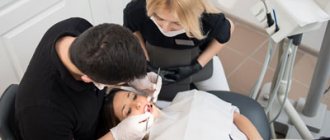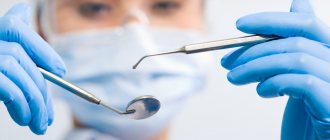The simplest manipulation for which sedation can be used?
Sedation in dentistry has its own peculiarities. All the manipulations are, in fact, simple for a professional in his work and his field; for him there is no difficulty in carrying out the same work without sedation. At the moment, the main factor why sedation is performed in dentistry is the patient’s fear. And if the patient has fear, treatment begins with sedation. If the patient has no fear, if he trusts the doctor, then the same can be done under local anesthesia, and the patient is only conscious. And the doctor can carry out the same amount of treatment for 4-5 hours, while he can take a break and the patient can rest, and then continue to treat teeth under local anesthesia.
Minimum time for a patient to be under sedation?
The minimum time for dental treatment under sedation is the local implementation of one manipulation.
It’s just that when sedation is chosen, they try not only to minimize the time, but, on the contrary, to maximize it, in order to do a larger volume due to the fact that the patient is afraid. So that in this short time, sedation allows you to carry out as much therapeutic work as possible with an adult patient. By the way, in the next video you can see how the implantation operation takes place under sedation
— installation of two Astra Tech implants. And the patient is me, the chief physician of the German Implantology Center, implant surgeon Dakhkilgov Magomed Umatgireevich. Implantation is carried out by my colleague, implant surgeon at the National Research Center Kolushev Gleb Valerievich:
How safe is sedation for human health?
Is sedation dangerous? Properly selected sedation cannot cause harm. If the patient has indicated all the features of his health and has undergone tests before the procedure, then the risk is minimized and there will be no harm to the patient’s health.
How often can sedation be used?
Depending on age, dental treatment with sedation can be done every week, but again, we are talking about the fact that doctors try to reduce its use to a minimum in frequency. “Better less, but better” - that is, it is better to do as much dentistry as possible under one-time sedation over a certain period of time, so as not to regularly put the patient into a state of half-asleep and not to increase the number of drugs and manipulations under sedation.
Maximum time under sedation per visit
This is determined by the anesthesiologist-resuscitator and, of course, the characteristics of the patient are taken into account. Sedation allows optimal treatment of teeth for about 4-5 hours. This is a comfortable time, despite the fact that the patient does not get very tired, because he lies in one position, and for the doctor this is also a comfortable time for work, because then there is a slight accumulation of fatigue, both for the doctor and the assistant, and at the patient. When the treatment time is more than 5 hours, the back and muscles become a little numb, and only after cooling it becomes less comfortable, the patient may begin to experience real discomfort.
Why are gum injections used in dentistry?
Any surgical intervention (amputation of teeth, removal of nerve endings in the root of a tooth, placement of a filling) causes an unpleasant painful sensation of varying degrees. Due to fear of pain, patients often postpone visiting the dentist, which leads to deterioration of the condition of their teeth. Local injections are made to numb the gums.
Another reason for injections into the gums is the administration of anti-inflammatory drugs and antibiotics in the treatment of gingivitis and periodontal disease. The question arises about intramuscular injections, since such manipulations also reduce inflammation and pain sensitivity.
Dentists administer local anesthesia for greater effectiveness and speed of reaction. If the anesthetic is administered intramuscularly, its effect will occur over a longer period of time.
Contraindications
Despite the effectiveness of an anesthetic injection into the gums, there are many absolute and relative contraindications.
Absolute contraindications to local anesthesia and anti-inflammatory injections on the gums:
- children under 3 years old;
- pregnancy and breastfeeding;
- increased sensitivity to drugs;
- patients with malignant arterial hypertension;
- a history of diabetes mellitus;
- diseases of the bronchopulmonary system.
Relative contraindications to manipulation will be:
- children under 7 years old;
- presence of problems with the liver and kidneys;
- oncological diseases (refers to antibiotic therapy);
- reduced immunity;
- gastrointestinal disease.
Indications and contraindications for molar tooth extraction
Dentists try to preserve the crown and root as long as possible, but this is not always possible. Tooth extraction has the following indications:
- it is impossible to apply methods of saving therapy to eliminate the infectious focus;
- acute stage of odontogenic osteomyelitis of the jaws;
- chronically injures the mucous membrane of the mouth or tongue;
- it is not possible to provide drainage from the infectious focus in the jaw;
- is retained, which causes the development of an infectious process;
- his destroyed crown is not suitable for prosthetics;
- periodontitis;
- for malocclusions, when removal can free up space for movements;
- if they are incorrectly located or supernumerary, they cause deformation of the row;
- is the only one on the jaw that interferes with the fixation of a full-fledged jaw prosthesis.
The removal operation has no absolute contraindications, but there are certain situations when the procedure should be postponed. Relative contraindications include conditions that require emergency therapeutic care:
- severe anemia;
- renal failure;
- heart rhythm disturbance;
- acute diseases of internal organs;
- vascular disorders;
- ARVI, influenza;
- chronic heart failure.
Also a contraindication is the first and second trimester of pregnancy.
Does it hurt to give an injection in the gum?
The painful process of needle penetration into the gum is insignificant, since dentists use small-diameter needles, damaging a small area of tissue of the oral mucosa.
Whether it hurts to give an injection in the gum is a question of the patient’s psychological state and his mood for treatment. Before performing the puncture, the doctor reassures the patient, reminding him that the injection is painless, since this manipulation is short-lived.
If the patient refuses anesthesia, the dentist warns about the increased likelihood of unbearable pain during surgical interventions, and any movements in the dental chair can lead to errors in treatment or complete ineffectiveness of the treatment measures taken.
People who have a high threshold for pain sensitivity are recommended to use anesthetic gels and sedatives (glycine, valerian, etc.) before going to the dental clinic (or before an injection while in line to see a doctor).
Application anesthesia is also used in other cases:
- if the patient exhibits a pronounced gag reflex during tooth preparation;
- when it is necessary to obtain intraoral X-rays or impressions of the jaw;
- to relieve pain in the marginal periodontium;
- in case of difficult eruption of wisdom teeth - for the period of excision of the hood above them;
- during a biopsy;
- during dissection of the frenulum;
- when performing curettage of periodontal pockets;
- in the treatment of minor destruction of tooth enamel, etc.
How to perform the manipulation
Anesthesia is administered depending on the area of the surgical intervention on the gums. For minor manipulations, the dentist uses a 2% lidocaine spray, sprinkling it on the injection site or applying an analgesic strip (Dentinox, Kalgel), waiting for the first manifestations of the analgesic.
If there are no undesirable reactions (allergic, inflammatory), the doctor proceeds to pierce the already numb gums. The injection site should be as close as possible to the diseased tooth to minimize damage to nearby healthy tissue (the development of gingivitis or periodontitis in the future).
Having opened the ampoules with the contents (analgesic), the medical specialist draws several syringes and injects the medicine into the gums layer by layer, starting from the outer layers.
Types of local anesthesia:
- Infiltration anesthesia – used in the treatment of caries, during the removal of dental nerves.
- Conduction anesthesia is when a nerve bundle is blocked during the treatment of several teeth located close to each other.
- Intraligamentous anesthesia - injection of the drug into the peribuccal fold of the mucous membrane (in the treatment of painters and pre-painters).
- Injection of the drug into the bone of the upper or lower jaw. Performed when implants are implanted or molars are removed, in particular wisdom teeth.
- Involvement of the nerve trunk - anesthesia for large-scale dental procedures. It is carried out with the support of an anesthesiologist in a hospital setting.
Content:
- Features of the use of anesthesia in pediatric dentistry
- Types of anesthesia in pediatric dentistry
- Local
- General
When treating primary teeth, dentists use different types of anesthesia. Thanks to anesthetics, even complex medical procedures are as comfortable as possible for a small patient. Therefore, parents do not need to worry - if they contact an experienced and responsible doctor, the child will undergo all the necessary procedures very easily.
The main causes of pain after injection into the gums
The main cause of pain after an injection is damage to the gums by the needle. Pain appears when the action of the analgesic subsides. Normally, the patient is in pain for 2-3 days, and after surgery (more damage - several injections) up to 14-15 days.
If the pain does not subside, but on the contrary, it begins to hurt more severely, you need to consult a doctor again. Such manifestations indicate the presence of acute inflammation, edema, infection or manifestations of postoperative complications (cyst, abscess).
Possible causes of prolonged pain after surgery may be: injuries during surgery; inadequate analgesia (without calculating how long an anesthetic injection lasts or the wrong combination of drugs).
Nerve trunk injury
Damage to the nerve trunk often occurs during conduction or trunk anesthesia, when the anesthetic enters the nerve fiber and kills some of the cells. Due to the death of brainstem neurons, the sensitivity of the innervated area decreases. Restoration of receptor function will occur without medical assistance.
Formation of hematoma on the gum
Since the gums are well supplied with blood, there is a high risk of hematoma formation during injections. Damage to small capillaries will not lead to the formation of large hematomas. But if you give an injection and get the syringe needle into a vessel of a larger diameter, the released blood will accumulate in the gum faster and to a greater extent. This forms a hematoma, causing discomfort and pain to the patient.
If a large hematoma is detected in the oral cavity, it is necessary to consult a dentist in order to reduce the risks of possible complications.
Allergy to anesthetic
Before the injection, doctors ask patients about the presence of allergic reactions to any drugs and review the patient’s medical record for allergies.
Considering these data, the medical specialist begins to administer anesthesia. An allergic reaction occurs instantly at the time of drug administration and is characterized by an increase in the characteristic clinical picture:
- the mucous membrane of the oral cavity swells;
- cheek swells;
- shortness of breath occurs;
- general excitement of the patient appears.
Therapeutic measures to eliminate allergies are carried out by a doctor in the dental chair: antihistamines and decongestants are administered, and the administration of the anesthetic or antibiotic that led to the body’s allergic response is stopped.
Necrotization of soft tissues
If anesthesia is inadequate (injection of a large amount of anesthetic) or an allergic reaction occurs at the time of drug administration, a complication such as necrosis of gum tissue may occur.
The necrotic area of the gum is dead cells that are no longer able to recover. If such a tissue area is insignificant, then the damaged area will be restored by neighboring healthy cells, while with large necrosis, scar formation occurs (replacement of cells with connective tissue).
Another cause of necrosis can be infection in the gum tissue and its rapid progression. If the next day a white spot appears at the injection site, surrounded by an inflammatory cushion, and the patient self-medicates without consulting a doctor again, irreversible tissue death may occur.
Clinical picture of gum necrosis:
- the appearance of plaque or blackening of the gums;
- formation of ulcers;
- bad breath;
- soreness around the lesion;
- increased body temperature;
- general malaise and chills.
Development of an infectious focus
Infection during medical procedures is possible due to poor sterilization of instruments or as a complication of improper postoperative care for the patient.
Contamination of the wound at the injection site causes a local response from the immune system - the formation of an inflammatory zone around the site. If you ignore the growing clinical picture or self-medicate, intoxication syndrome appears (febrile temperature, weakness, loss of appetite).
Treatment in a dental clinic will be aimed at eliminating the causative agent of infection (antibiotic therapy) together with the use of antihistamines and anti-inflammatory drugs.
How to get rid of pain after anesthesia
If the pain does not subside within a week after the manipulation, but, on the contrary, intensifies, becoming pulsating, you should consult a doctor. You should not self-medicate, since ordinary inflammation, which causes pain, can be complicated by the addition of an infection, and treatment will become more protracted and difficult.
At first, when the pain is still severe, strong non-steroidal anti-inflammatory drugs help:
- Xefocam;
- Nurofen;
- Nimesulide;
- Ketanov.
It is important to take into account their harmful effects on the gastrointestinal tract and avoid overdoses.
Precautions after anesthesia
In order for the rehabilitation period to proceed safely, some points should be taken into account:
- Eliminate hot, spicy, salty foods from your diet.
- Do not take solid food for the first 3 days.
- Maintain oral hygiene (temporarily eliminate the toothbrush and replace with mouthwash).
- Give up bad habits (smoking, alcohol).
- Keep records of changes in the general condition of the body (body temperature, general well-being).
- Avoid emotional disturbance.
Taking all these points into account, the patient significantly reduces the risk of complications during the rehabilitation period. The pain that arose after the treatment should not worry the patient on the first day. If your gums hurt for a long period after an anesthesia injection, this is a reason to seek medical help from a dentist again.
Category Miscellaneous Published by kosmetik-dent










